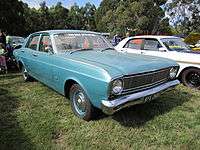Ford Falcon (XT)
The Ford Falcon (XT) is a full-size car that was produced by Ford Australia from 1968 to 1969. It was the second iteration of the second generation of this Australian-made model and also included the Ford Fairmont (XT)—the luxury-oriented version of the Falcon.
| Ford XT Falcon | |
|---|---|
Ford Falcon GT (XT) | |
| Overview | |
| Manufacturer | Ford Australia |
| Also called | Ford XT Fairmont |
| Production | March 1968–June 1969 |
| Body and chassis | |
| Class | Full-size car |
| Body style | 4-door Sedan 5-door Station Wagon 2-door Coupé utility 2-door Van |
| Related | Ford ZB Fairlane |
| Powertrain | |
| Engine | 3.1 L (188 CID) 6-cyl 3.6 L (221 CID) 6-cyl 5.0 L (302 CID) V8[1] |
| Transmission | 3spd manual 4 speed manual GT only 3spd “Fordomatic” automatic 3spd “SelectShift Cruis-o-matic” automatic[1] |
| Dimensions | |
| Length | 4,689 mm (184.6 in) |
| Width | 1,875 mm (73.8 in) |
| Height | 1,389 mm (54.7 in) |
| Curb weight | 1,324 kg (2,918.9 lb) (sedan) |
| Chronology | |
| Predecessor | Ford XR Falcon |
| Successor | Ford XW Falcon |
Introduction
The XT Falcon range was introduced in March 1968[2] as a facelifted version of the XR Falcon, which it replaced. The XT featured a revised grille and taillights and improved safety features including split-system brakes, larger tyres and electrically operated windscreen washers.[3]
Standard equipment in the luxury Fairmont models included bucket seats, front disc brakes, a heater/demister, a wood-grain dash, carpet and courtesy lamps in all four doors.[3] The Fairmont Wagon featured an electrically operated tailgate.[3]
Model range
The XT was offered in 4-door Sedan, 5-door Station Wagon, 2-door Utility and 2-door Van variants as follows.
- Falcon Sedan
- Falcon 500 Sedan
- Fairmont Sedan
- Falcon GT Sedan
- Falcon Wagon
- Falcon 500 Wagon
- Fairmont Wagon
- Falcon Utility
- Falcon 500 Utility
- Falcon Van
The luxury Fairmont models were not badged or marketed as Falcons.[1]
The XT Falcon GT, which was introduced two months after the other models in May 1968, was the performance model in the range.[4]
 Ford XT Falcon sedan
Ford XT Falcon sedan.jpg) Ford XT Falcon 500 sedan
Ford XT Falcon 500 sedan.jpg) Ford XT Falcon 500 sedan
Ford XT Falcon 500 sedan.jpg) Ford XT Falcon 500 wagon
Ford XT Falcon 500 wagon.jpg) Ford XT Falcon 500 wagon
Ford XT Falcon 500 wagon.jpg) Ford XT Fairmont sedan
Ford XT Fairmont sedan.jpg) Ford XT Fairmont (non standard wheels)
Ford XT Fairmont (non standard wheels)- Ford XT Falcon GT sedan
.jpg) Ford XT Falcon GT sedan
Ford XT Falcon GT sedan.jpg) Ford XT Falcon utility (non standard wheels)
Ford XT Falcon utility (non standard wheels).jpg) Ford XT Falcon utility
Ford XT Falcon utility- Ford XT Falcon 500 utility
.jpg) Ford XT Falcon 500 utility
Ford XT Falcon 500 utility
Engines
Four engines were offered in the XT range, all with increased capacity.
- 3.1 L (188 CID) 114 bhp six-cylinder was standard on Falcon and Falcon 500 models[1]
- 3.6 L (221 CID) 135 bhp six-cylinder was standard on Fairmont models and optional on Falcon and Falcon 500[1]
- 5.0 L (302 CID) 210 bhp V8 was optional on Falcon, Falcon 500 and Fairmont[1]
- 5.0 L (302 CID) 230 bhp V8 was standard on Falcon GT[4]
Engine capacity was now officially quoted in litres rather than cubic inches.[3]
Production & replacement
After a production run of 79,290 vehicles[5] the XT Falcon was replaced by the XW Falcon in June 1969.
Motorsport
An XT Falcon GT driven by Bill Gates and Jim Bertram scored an outright victory in the 1969 Rothmans 12 Hour Classic race for production cars at Surfers Paradise International Raceway on 5 January 1969.[6]
A team of three XT Falcon GTs won the Teams prize in the 1968 London-Sydney Marathon,[4] finishing 3rd, 6th and 8th outright.[3]
References
- Ford Australia sales brochure FXT2/68/5
- Glass’s Dealers Guide, South Australian and Northern Territory Edition, June 1973, page 50
- Ford Falcon XT Retrieved from www.uniquecarsandparts.com.au on 15 April 2010
- Ford Falcon XT GT Retrieved from www.uniquecarsandparts.com.au on 15 April 2010
- Falcon XT Technical Specifications Retrieved from www.uniquecarsandparts.com.au on 15 April 2010
- Sweet Smell of Success, Racing Car News, February 1969, pages 30-33
External links
| Wikimedia Commons has media related to Ford Falcon (XT). |